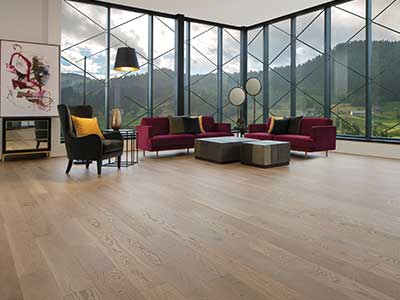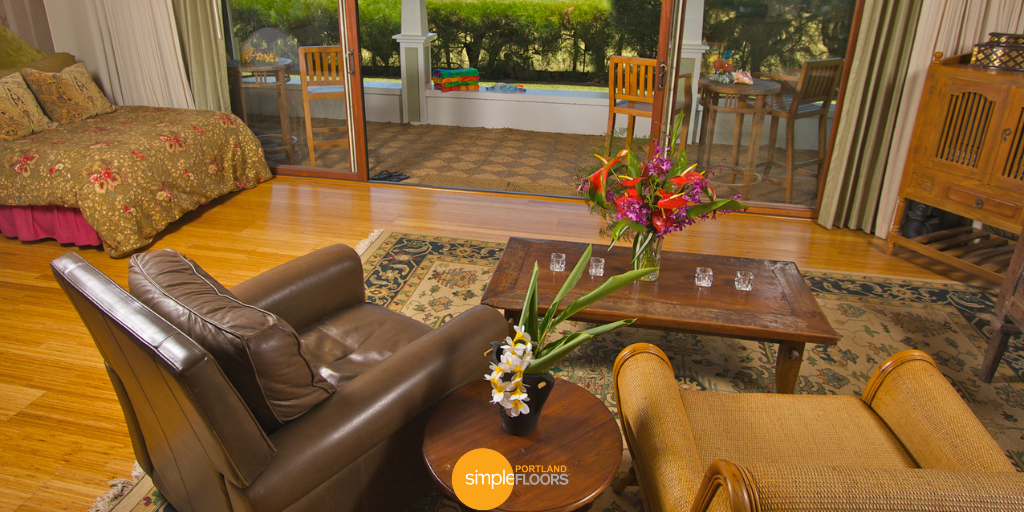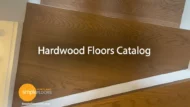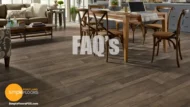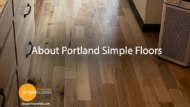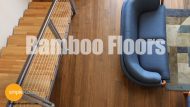Bamboo hardwood flooring has been used for centuries as a green and easy-to-maintain flooring option. The process has been refined over the years. It’s crafted from the stalks of the bamboo plant in multiple ways to produce a variety of finishes.
Because bamboo is highly sustainable (it can grow 1.5 inches/hour once established), it is a wonderful environmentally friendly option for your home.
Bamboo flooring can also be ant and termite-resistant depending on how the wood was treated.
How to Choose Bamboo Flooring
The first question you need to ask when choosing flooring is where do you want it to go. Then look around that room and see how the room feels. What colors are you already using? Do you want to completely redo the room, or do you want your bamboo flooring to blend in?
Finally, do you want finished or unfinished flooring. Most bamboo floorings come finished unless there’s a particular way you wish your floor to be installed. You will want to work with a professional if you need it to be finished after installation.
Types of Bamboo Flooring
There are three types of grains for bamboo flooring: vertical, horizontal, and strand-woven. It’s determined by how the bamboo is glued together as the final wood is created.
Strand-woven is the most durable, rating as high as 5,000 Janka hardness scale which is harder than red oak.
Vertical grain looks more like standard hardwood flooring. And the horizontal grain looks a little like pine.
Like hardwood floors, you can get different surface styles, including smooth, wire-brushed, antiqued, and more.
The higher the quality you choose ensures the bamboo flooring will be more water and ding resistant.
Colors and Patterns for Bamboo Flooring Planks
Bamboo boards take stain easily, providing you with endless choices. The flooring can also be created with different grain patterns, and are available in tiles and planks.
Tends to be on the lighter shades. If you want darker, there is a process to carbonize bamboo. Carbonizing is what it sounds like. The bamboo is placed in extreme heat and baked, which creates a rich, dark hue. The downside is that these floors are not as durable as non-carbonized bamboo.
Where to Install Bamboo Flooring
Natural bamboo flooring is extremely durable as well as water resistant. You can install it in basements, bathrooms, living rooms, family rooms, kitchens, and everywhere in between. Because it’s scratch resistant, it’s very pet friendly.
There is also less warping over time than hardwood flooring.
Bamboo Hardwood Flooring Care
You will want to vacuum or sweep the floor regularly to keep the gritty stuff from wearing down your floors. You will want a soft-bristle attachment as well. It’s best to use a stick vacuum rather than a canister or heavy upright.
Clean up all spills right away to keep the liquid from penetrating and being absorbed into the bottom of the boards. That leads to warping.
When mopping, go lightly with the liquid and ensure the floor dries completely. Don’t apply any finishes or waxes unless specifically recommended by the flooring manufacturer.
If you have a water stain or discoloration, some people have successfully treated this with a dollop of real mayonnaise. Let it sit for at least 15 minutes, wipe it off, and then polish the area with a soft cloth.
Scuff marks can be cleaned up with a bit of elbow grease, wood floor cleaner, and a soft rag. You can avoid scuff marks by having your bamboo floors be a no-shoes zone.
Finally, never steam-clean your bamboo floors.
Engineered Bamboo Flooring vs Solid Bamboo Flooring
Like other engineered floors, engineered bamboo flooring is a layer of bamboo flooring over composite layers. Solid bamboo flooring is only made from bamboo. They can look the same, but the hardwood flooring is going to be more durable than the engineered planks. But not by much.
Engineered bamboo flooring has a 3000 Janka rating. And like other engineered flooring, you can install the planks yourself.
Both are easy to maintain and come in a variety of colors, grain lines, and textures to match your home’s decoration.
Installing Your Bamboo Floor
Bamboo flooring can be installed with a variety of methods, including glue, floating, or nail. It depends on the type of flooring, and your home’s subfloor.
There is a myth that bamboo flooring can’t go over concrete. It can. You just need to apply a concrete vapor barrier first to prevent mold, mildew, and other moisture-related issues.
Good quality bamboo flooring only needs about three days to settle in after installation. Lower quality may take up to two weeks. All wood flooring needs time to acclimate to the environment.
Can Bamboo Floors be Refinished?
You shouldn’t need to sand and re-seal your bamboo floor. However, sometimes people want to refresh the flooring and remove any stains. The whole floor will need to be done. It’s not recommended to do spot repairs.
Is Bamboo Flooring Right for you?
If you want the look of hardwood floors that are durable and ding resistant at an affordable price and it’s eco-friendly, you may want to look into bamboo flooring. Check out our online catalog and contact us with any questions.

